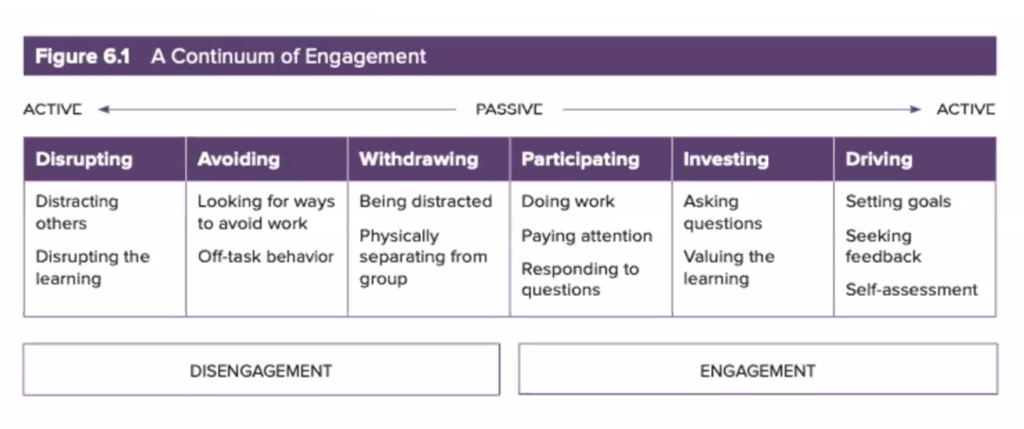I participated in a distance learning institute recently where over 500 educators were asked how they measured engagement. Many responded with eye contact, nodding along, cameras on, answering questions… These same measures are also valued in school when we are face to face although they equate more to compliance and tell us very little about what students are understanding, what they are thinking, and what they can do with what they know.
In a recent research study shared in the Distance Learning Playbook, Amy Berry has defined these behaviors such as turning in work, paying attention, and responding to questions as “participating.” What I think is important to point out is that she also describes these behaviors are passive behaviors that have little impact on memory, retention or learning. I would also add joy to that list.
If we continue to mistake sitting up straight with cameras on as engagement without creating opportunities for authentic and meaningful learning on and off the computers, we will lose students before we even get started. Worse yet, we will miss the opportunity to help learners learn to set goals, track progress and drive their own learning, which is where the true engagement exists.

Many have acknowledged that the spring was hard but there were some bright spots such as a focus on relationships, flexibility, choice, feedback, and more creativity. As I talk to teachers, students, parents, and see the exhaustion, stress and frustration that so many are experiencing as a result of our attempts to improve the experience from the fall, we have now in too many cases swung the pendulum to recreate a full day of school online while leaving behind the best parts of what we learned over the spring.
In the last 6 months there has been more change, more uncertainty and more loss than many of us have experienced in a lifetime. I wonder why we are clinging to these lesson plans, schedules, and completing assignments that have little to no relevance for many. In a world where nothing looks the same and everything has to be reinvented, we don’t have to do it this way, yet we still are. I keep asking myself, “How can we design our school days with more compassion, agency, and joy?”
Looking for Bright Spots
As I do when I trying to understand something new, I ask, wonder, and search for what is working. In this quest, I read this article, “I Hate the Pandemic, but I’m Grateful to Be Rid of Grades” and it is giving me hope to see an example of how her grading policy (and the district’s) shifted and allowed her to prioritize what really matters.
“I am now a teacher who coaches, instead of a boss who demands a certain number of sentences or paragraphs, dangling that grade A paycheck just out of arm’s reach. I am asked to give feedback. “Can you read my first paragraph?” “Can I write directly to the virus?” “Do you think if I say life before was a roller coaster, and now it’s a carousel, people would get it?” These are some of the questions I get. Instead of plugging grades robotically into the Synergy grading system, I write detailed feedback for each student’s piece of writing and watch it bloom into a beautiful narrative. I feel their grief, anger, and hope as they describe missing graduations and family vacations. They write how they miss hugging their friends, feeling the beach sand between their toes, crossing the finish line after a grueling track meet, and they wonder how this pandemic will shape them and the world around them.
I’ve decided all of my students are going to pass. Because living through a damn pandemic is passing.
Read that again, “Because living through a damn pandemic is passing.” And that is true for all of us, not just our students.
Engagement should be defined by so much more than cameras on and showing up to each period or class on zoom all day. Just because students are there doesn’t mean they are learning. Also, if teachers are running virtual (and in some cases virtual and in person) classes all day, they don’t have time (or energy) to connect with kids in small groups, mentor them, and provide the meaningful feedback that is so much more valuable to the learning process. In the above graphic on the far right of the engagement continuum, where more learning (and joy) happens, is setting goals, seeking feedback, and self assessment. This is when students are driving their learning.
When Students Drive Their Learning
We can teach necessary skills while creating experiences that allow learners to take ownership of the process. Learners have access to an abundance of resources and experts that enable us all to learn in ways that extend beyond the expertise of one teacher or classroom. By tapping into those resources, we can create more experiences that can allow students to apply their newly learned skill in ways that are meaningful and relevant to them and others.
In order to create opportunities for learners to seek information and learn to learn, here are 6 questions that you could pose to promote learner agency and encourage learners to wonder, explore, and drive their learning (yes, even within your content and standards).
- What do you know and what do you still need to learn?
- What resources i.e books, articles, videos might help you learn more?
- How does this connect to what you already know?
- What are some creative ways to solve this problem?
- Who are the experts you can learn from?
- How will you share what you are learning?
To support engagement, where students are driving their learning it is critical that we are asking these questions (and more) and helping learners understand that learning is a lifelong pursuit rather than something we do for a test or for the teacher. When we focus on learners, connect to their interests, needs, and goals, we can create experiences that ignite curiosity, develop passion, and unleash genius.
Instead of expecting students and teachers to be confined to a computer for 6 hours and recreate the school day online, we know learners are more engaged and motivated by authentic, participatory, and relevant learning experiences. Outside of the structure of a classroom it matters more than ever that kids are engaged in projects that matter to them. Consider how you can best leverage the desired learning goals, interests, resources and context at home to meet the learning goals in a way that makes sense for them.
4 Ways to Increase Engagement in Distance Learning
Agency is about moving students from passively responding to acting with purpose to reach a desired goal or outcome. When students have an authentic purpose and audience beyond their teacher to share what they are learning, they are more motivated to learn and often go above and beyond.
Investigate Issues That Matter
Educator, Teague Tubach Shared how he gave his students a choice about what to research and investigate for their persuasive essay. He shares how students were learning in the article, Exploring Social Justice Through PBL:
‘As they learned, they talked. They talked with friends and classmates, with me and their families, and with community members. Some attended protests. What might have been a trivial “What did you learn in school today?” turned into a powerful discourse on injustice and the human condition.’
This doesn’t have to (and actually cannot) all happen with a whole group on Zoom all day. This is the result of clear goals and purpose and the freedom and flexibility to leverage a variety of resources to investigate and deeply learn about a topic or issue. Students are motivated and inspired to research issues that matter to them and others, to read, to write, to examine, and to create something as a result.
Document and Share the Experience
This will be a moment in time the historians will use our stories, pictures, memes- How do you want your story to be recorded? How might you help your students make sense of their world. There is great value in documenting a day in life through journal, photography, art, video journals.
Or you can take it a step further like this group of nine teenagers who recently published, QuaranTEEN: Our New Normal, which is a best selling book and a project that could help students young and old develop reading, writing, and communicating skills while learning about themselves and others. This is a perfect example of a project that could inspire more compassion, joy, and agency in learning.
Work With Your Community to Solve Problems That Matter
Last week I was working with the Leadership team in Logan County, Kentucky to align practices with their profile of success and each site team was focused on what would make the most impact at their site. Lori Bouldin and Jonathan Stovall at Adairville School wanted to support their teachers to create more authentic projects and support their community in needs. They decided to set up a process for teachers to “speed date” with community members to understand their authentic problems and create time to codesign projects for their classes. I love how these two leaders are working to engage and empower their teachers so that they can create amazing opportunities for their students.
Empower Learners With Voice and Choice
There are times that we want students to practice, build foundational skills, or research to support their projects and dig deeper into new concepts. This can be done asynchronously and allow students to take more ownership over the process. When we have more voice and choice in what and how we learn, we are often more invested in the process. This is a great opportunity for students to make choices about what to learn but also how they go about learning. John Spencer’s article, 4 ways to Craft Choice Menus in Distance Learning provides a variety of examples of how you can create choice boards based on the desired level of student agency and the goals of the task.
Reflecting to Move Forward
Our own experiences and habits are such a powerful force and impact our actions. When we want a different outcome we have to challenge our own process, assumptions, and actions as we work to create new norms and systems. We will continually have to ask ourselves,
- What is the goal?
- Why are we doing it this way?
- Is this having the impact I was hoping for?
- Is there a better way?
We all operate within constraints but we don’t have to all do things the same way to reach the intended learning targets and goals. Educators have certain expectations they are accountable for teaching and there is a variety of content and skills that we want students to learn. Within the content, there can still be opportunities for learners to have choice and opportunities to drive their own learning process with shared goals and expectations. And especially now, in the middle of the pandemic, we must examine what matters most, what we can let go of and what we want to do more of and keep working to make those things the priority.



Aloha Katie-
So many gold nuggets to guide learning (and teaching) now and for the future-distance, hybrid, or face to face.
Mahalo
Sheila
Thank you for another inspiring article, Katie. many of us here, in Johannesburg are daily trying to move further and further in the direction suggested here. We value your ongoing input which I circulate regularly! Keep safe. Anthony
Glad to hear that it is helpful, Anthony!